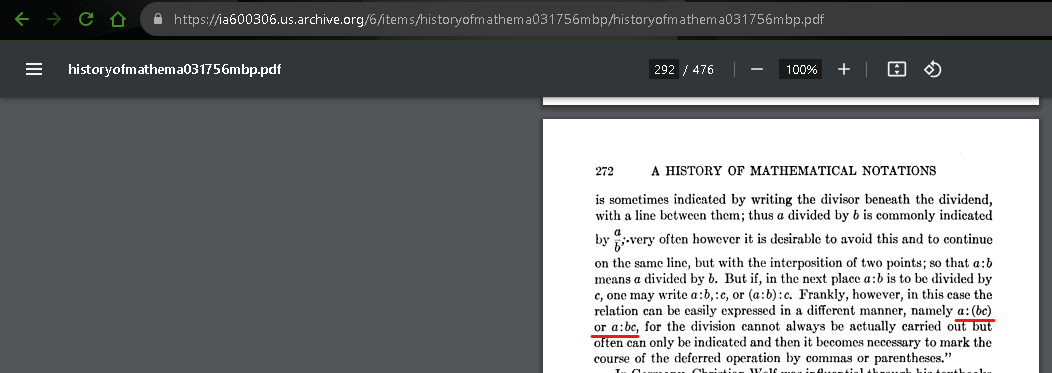watches the people with basic math skills fight to the death over the answer
If you really wanna see a bloodbath, watch this:
You know that a couple has two children. You go to the couple’s house and one of their children, a young boy, opens the door. What is the probability that the couple’s other child is a girl?
50%, since the coins are independent, right?
Oops, I changed it to a more unintuitive one right after you replied! In my original comment, I said “you flip two coins, and you only know that at least one of them landed on heads. What is the probability that both landed on heads?”
And… No! Conditional probability strikes again! When you flipped those coins, the four possible outcomes were TT, TH, HT, HH
When you found out that at least one coin landed on heads, all you did was rule out TT. Now the possibilities are HT, TH, and HH. There’s actually only a 1/3 chance that both are heads! If I had specified that one particular coin landed on heads, then it would be 50%
No. It’s still 50-50. Observing doesn’t change probabilities (except maybe in quantum lol). This isn’t like the Monty Hall where you make a choice.
The problem is that you stopped your probably tree too early. There is the chance that the first kid is a boy, the chance the second kid is a boy, AND the chance that the first kid answered the door. Here is the full tree, the gender of the first kid, the gender of the second and which child opened the door, last we see if your observation (boy at the door) excludes that scenario.
1 2 D E
B B 1 N
B G 1 N
G B 1 Y
G G 1 Y
B B 2 N
B G 2 Y
G B 2 N
G G 2 Y
You can see that of the scenarios that are not excluded there are two where the other child is a boy and two there the other child is a girl. 50-50. Observing doesn’t affect probabilities of events because your have to include the odds that you observe what you observed.
Yes! They responded to my comment before the edit, where I gave the coin example: “I flipped two coins, at least one of them was heads. What is the probability that both of them are heads?”
Before I read their reply, I edited it to the more confusing and infuriating two kids example. It’s annoying because it seems like it should be the same as saying “I have two children, and at least one is a boy. What is the probability that I have two boys?” In both the coin case and this one, the answer is 1/3, but when one child answers the door, it’s like sliding one quarter out from behind my hand. Now you know a particular (child, coin)'s (sex, face), and the answer is 50% again.
deleted by creator
You assume that the probability of TH = HT = HH
When In fact, the probabilities are as follows:
P(HT)+P(TH) = 50% P(HH) = 50%
For all the probabilities being equal, you’d have to consider 4 cases:
HT, TH, HH (1) and HH (2).
The difference between HH (1) and HH (2) is which one you were told that was heads.
Then P(HH) = P(HH (1)) + P(HH (2)) = 2/4 = 50%
The issue is that you weren’t told a particular one was heads, only that at least one was heads. If I flipped a nickel and a dime, then the four possibilities are NtDt, NtDh, NhDt, and NhDh. If I say that at least one of them is heads but don’t tell you which one, then there are three possibilities: I flipped NhDt, NtDh, or NhDh. It’s only when I tell you that the nickel landed on heads that it collapses to NhDt and NhDh.
Sorry if the acronyms are hard to read, they’re much faster than typing something like “Heads (nickel) tails (dime)”
deleted by creator
Again, you are assuming that every occurrence has the same chance. When in fact, they have not. There are 3 random events happening here:
- Flip of one coin (50% chance each)
- Flip of the other coin (50% chance each)
- The coin that you told me (let’s say it’s 50% nickel 50% dime for simplicity’s sake)
Also, I am assuming that these 3 events are completely unrelated. That is, the result of a coin flip won’t determine whether you tell me the nickel or dime. A complete list of events is as follows:
T T N
T T D
H T N
H T D
T H N
T H D
H H N
H H D
After telling me that one of them is heads, the list is as follows:
H T D
T H N
H H D
H H N
H H is 50% chance, and the sum of HT + TH is the other 50%
This is very easily simulated. I use Tasker, you can use Python or something. Assume 1 is heads and 2 is tails
-
Randomize variable %dime to 1 or 2
-
Randomize variable %nickel to 1 or 2
This flips two coins. At this point there’s a 25% chance of each TT, TH, HT, and HH occurring.
- Goto 1 IF %dime != 1 AND %nickel != 1
This is the point where I tell you that at least one of them is heads, but not which. It flips the coins again only if they landed TT, which means there are three possible sets of coins now: TH, HT, or HH.
-
Add 1 to variable %HeadsTails IF %dime = 2 OR %nickel = 2
-
Add 1 to variable %HeadsHeads IF %dime = 1 AND %nickel = 1
This keeps track of what sets made it past line 3. If either is tails, it adds one to %HeadsTails. If neither is tails, then it adds one to %HeadsHeads
-
Add 1 to variable %Counter
-
Goto 1 IF %Counter <1000
You can set your counter as high as you like. Python would probably handle 10,000 flips faster than Tasker can handle 1,000, but I’m on my phone and also python illiterate.
Press play, and I get 357 sets with two heads, and 643 sets that have a tails. The longer it runs, the closer to a ratio of 1:2 it’ll get.
-
You’ve also ruled out TH by knowing one is heads. So the only possibilities are HT and HH. Is that not 50/50?
At least one is heads, but unless you know which one it is, you haven’t ruled out HT or TH
But you do know which one it is, because you said “other child”. As soon as you ask the question, you assign a specific outcome to a specific child eliminating HH and HT (or in the new example, BB and BG). “What are the odds they have a female child” and “what are the odds the other child is female” are not the same question.
it depends on how you know this information. did you look at one of the coins? then it’s 50/50. did you ask a friend to look and yell you whether at least one of them is heads? then it’s 2/3.
This is a ridiculous argument when taken to the extreme. Say you have three bags. Bag A contains 100 blue marbles. Bag B contains 99 blue marbles and 1 red marble. Bag C contains 100 red marbles. You reach into a random bag and draw a red marble. You’ve only eliminated bag A. Would you say it is a 50-50 whether you are left with a bag now containing 99 blue marbles or 99 red marbles? No, the fact that you drew a red marble tells you something about the composition of the bag you drew from. The odds that you drew out of bag B is 1/101, the total number of red marbles in bag B divided by the total number of red marbles across all bags. The odds that you are dealing with bag C is 100x that.
Now let’s say you have 4 bags. BB, BR, BR, and RR. You draw an R. There is a 50% chance you are dealing with bag 2 or 3 because together they contain 2 out of 4 R. There is also a 50% chance you are dealing with bag 4. So it is equally likely that you draw either color of marble if you take the remaining marble out of the bag you randomly selected despite there being twice as many BR bags as RR bags.
Cheeky bastard.
It is 50-50, though. The remaining possible states are BG and BB. Both are equally likely. Any further inference is narrative… not statistics.
The classic example of this is flipping 100 coins. If you get heads 99 times in a row… the last coin is still 50-50. Yes, it is obscenely unlikely to get heads 100 times in a row. But it’s already obscenely unlikely to get heads 99 times in a row. And it is obscenely unlikely to alternate perfectly between heads and tails. And it is obscenely unlikely to get a binary pattern spelling out the alphabet. And it is obscenely unlikely to get… literally any pattern.
Every pattern is equally unlikely, with a fair coin. We see 99 heads in a row versus 1 tails at the end, and think it narrowly averted the least-probable outcome. But only because we lump together all sequences with exactly one tails. That’s one hundred different patterns. 1-99 is not the same as 99-1. We just treat them the same because we fixate on uniformity.
Compare a non-binary choice: a ten-sided die. Thirty 1s in a row is about as unlikely as 100 heads in a row. But 1 1 1… 2 is the same as 1 1 1… 3. Getting the first 29 is pretty damn unlikely. One chance in a hundred million trillion. But the final die can land on any number 1-10. Nine of them upset the pattern our ape brains want. Wanting it doesn’t make it any more likely. Or any less likely.
It would be identically unlikely for a 10-sided die to count from 1 to 10, three times in a row. All the faces appear equally. But swap any two events and suddenly it doesn’t count. No pun intended.
If this couple had eight children, for some god-forsaken reason, and you saw seven boys, the eighth kid being another boy is not less likely for it. The possibility space has already been reduced to two possibilities out of… well nine, I suppose, if order doesn’t matter. They could have 0-8 boys. They have at least 7. The only field that says the last kid’s not a coin toss is genetics, and they say this guy’s chromosome game is strong.
You’re right, but it’s not a subversion of the Gambler’s Fallacy, it’s a subversion of conditional probability. A classic example is that I have two kids, and at least one of them is a boy. What is the probability that I have two boys?
The intuitive answer is 50%, because one kid’s sex doesn’t affect the other. But when I told you that I have two kids, there were four possibilities: GG, GB, BG, or BB. When I told you that at least one of them is a boy, all I did was take away the GG option. That means there’s only a 1 in 3 chance that I have two boys.
But by having one child answer the door, I change it yet again–now we know the sex of a particular child. We know that the child who opened the door is a boy. This is now akin to saying “I have two children, and the eldest is a boy. What is the possibility that I have two boys?” It’s a sneaky nerd snipe, because it targets specifically people who know enough about statistics to know what conditional probability is. It’s also a dangerous nerd snipe, because it’s entirely possible that my reasoning is wrong!
i hate it when ppl do nb erasure for their stupid math text problems. use anything else pls
What’s the probability of the other kid being non-binary?
And don’t forget that there’s always a slim chance that no matter the gender, the other child is GOAT.
Two more for funsies! I flipped two coins. At least one of them landed on heads. What is the probability that both landed on heads? (Note: this is what my comment originally said before I edited it)
I have two children. At least one of them is a boy born on a Tuesday. What is the probability that I have two boys?
deleted by creator
Different compilers have robbed me of all trust in order-of-operations. If there’s any possibility of ambiguity - it’s going in parentheses. If something’s fucky and I can’t tell where, well, better parenthesize my equations, just in case.
There’s quite a few calculators that get this wrong. In college, I found out that Casio calculators do things the right way, are affordable, and readily available. I stuck with it through the rest of my classes.
Casio does a wonderful job, and it’s a shame they aren’t more standard in American schooling. Texas Instruments costs more of the same jobs, and is mandatory for certain systems or tests. You need to pay like $40 for a calculator that hasn’t changed much if at all from the 1990’s.
Meanwhile I have a Casio fx-115ES Plus and it does everything that one did, plus some nice quality of life features, for less money.
$40??!! My ti that was required was like over $200!!
TI did the same thing Quark and Adobe did later on – got dominance in their markets, killed off their competition, and then sat back and rested on their laurels thinking they were untouchable
EDIT: although in part, we should thank TI for one thing – if they hadn’t monopolized the calculator market, Commodore would’ve gone into calculators instead of computers
https://en.wikipedia.org/wiki/TI-99/4A
It was a huge failure, but they tried.
Huge failure my ass. Come at me on munch man, Alpiner, or Tombstone City. Or coding vaguely racist things like Mr. Bojangles, one of the first codes in the early books.
Had one at home and used the hell out of it, don’t get me wrong. Was my first computer. Played the Zork series on that thing. But, it had issues and wasn’t a financial success.
It had fewer issues than almost anything I’ve owned since. I bet it would still work if I got the right adaptors. Wasn’t a huge financial success though. They seemed content with early coding and games, and didn’t move into word processing etc.
If you’re lucky, you can find these TI calculators in thrift shops or other similar places. I’ve been lucky since I got both of my last 2 graphing calculators at a yard sale and thrift shop respectively, for maybe around $40-$50 for both.
The TI equivalent to the Casio fx-115ES Plus is the TI-36X Pro, and they both cost $20 at Walmart.
My Casio calculators get this wrong, even the newer ones. BTW the correct answer is 16, right?
- 16 is the right answer if you use PEMDAS only:
(8 ÷ 2) × (2 + 2) - 1 is the right answer if you use implicit/explicit with PEMDAS:
8 ÷ (2 × (2 + 2)) - both are correct answers (as in if you don’t put in extra parentheses to reduce ambiguity, you should expect expect either answer)
- this is also one of the reasons why postfix and prefix notations have an advantage over infix notation
- postfix (HP, RPN, Forth):
2 2 + 8 2 ÷ × . - prefix (Lisp):
(× (÷ 8 2) (+ 2 2))
- postfix (HP, RPN, Forth):
prefix notation doesn’t need parentheses either though, at least in this case. lisp uses them for readability and to get multiple arity operators. infix doesn’t have any ambiguity either if you parenthesize all operations like that.
infix doesn’t have any ambiguity either if you parenthesize all operations like that
There isn’t any ambiguity even if you don’t.
16 is the right answer if you use PEMDAS only: (8 ÷ 2) × (2 + 2)
You added brackets and changed the answer. 2(2+2) is a single term, and if you break it up then you change the answer (because now the (2+2) is in the numerator instead of in the denominator).
1 is the right answer
The only right answer
both are correct answers
Nope, 1 is the only correct answer.
this is also one of the reasons why postfix and prefix notations have an advantage over infix notation
Except they don’t. This isn’t a notation problem, it’s a people don’t remember the rules of Maths problem.
deleted by creator
PEMDAS is actually (PE)(MD)(AS). Those that are grouped together have equal precedence and are evaluated left to right.
8 / 2 * (2+2)
8 / 2 * 4
4 * 4
16
Edit to fix formatting, maybe?
8 / 2 * (2+2)
When you added the multiply you changed the answer, because the (2+2) is now in the numerator instead of in the denominator.
- 16 is the right answer if you use PEMDAS only:
Yes
8 / 2 (2+2)
8 / 2 (4)
4 (4)
16
No
8 / 2 (2+2)
8 / 2 (4)
8 / 8
1
No. Order of operations is left to right, not right to left. 1 is wrong.
Order of operations is left to right
Order of operations is BEDMAS, THEN left to right within each operator.
1 is wrong
1 is the only correct answer.
a(b) is a×b. Step 2 could be rewritten as 8 / 2 × 4. Working left to right, step 3 becomes 4 × 4.
a(b) is a×b
a(b) is (a×b) - you can’t remove brackets unless there is only 1 term left inside.
8/(2x4)=8/8=1
deleted by creator
Yes
No.
8 / 2 (4) 8/(2x4) 8/8 1
deleted by creator
No, 8 / 2 happens before 2 * 4
That’s (2x4). Doing division before brackets goes against the order of operations rules.
deleted by creator
Division and multiplication are equal in the order of operations
I didn’t say they weren’t. I said…
Doing division before brackets goes against the order of operations rules
You did 8/2x4, which is the same as (8/2)(2+2), which isn’t the same as 8/2(2+2)=8/2(4)=8/(2x4).
Depends on the system you use. Most common system worldwide and in the academic circles (the oldest of the two) has 1 as the answer.
Depends on the system you use
There are no other systems - only people who are following the actual rules of Maths and those who aren’t. And yes, 1 is the correct answer
the correct answer is 16, right?
deleted by creator
Sharp as well.
Ditto for Sharp. It’s really only Texas Instruments that is the ongoing exception to the rule.
In some countries we’re taught to treat implicit multiplications as a block, as if it was surrounded by parenthesis. Not sure what exactly this convention is called, but afaic this shit was never ambiguous here. It is a convention thing, there is no right or wrong as the convention needs to be given first. It is like arguing the spelling of color vs colour.
BDMAS bracket - divide - multiply - add - subtract
BEDMAS: Bracket - Exponent - Divide - Multiply - Add - Subtract
PEMDAS: Parenthesis - Exponent - Multiply - Divide - Add - Subtract
Firstly, don’t forget exponents come before multiply/divide. More importantly, neither defines wether implied multiplication is a multiply/divide operation or a bracketed operation.
neither defines wether implied multiplication is a multiply/divide operation or a bracketed operation
The Distributive Law says it’s a bracketed operation. To be precise “expand and simplify”. i.e. a(b+c)=(ab+ac).
Exponents should be the first thing right? Or are we talking the brackets in exponents…
Exponents are second, parentheses/brackets are always first. What order you do your exponents in is another ambiguity though.
What order you do your exponents in is another ambiguity though
No it isn’t - top down.
234 is ambiguous. 2(34) is standard practice, but some calculators aren’t that smart and will do (23)4.
It’s ambiguous because it works both ways, not because we don’t have a standard. Confusion is possible.
The only confusion I can see is if you intended for the 4 to be an exponent of the 3 and didn’t know how to do that inline, or if you did actually intend for the 4 to be a separate numeral in the same term? And I’m confused because you haven’t used inline notation in a place that doesn’t support exponents of exponents without using inline notation (or a screenshot of it).
As written, which inline would be written as (2^3)4, then it’s 32. If you intended for the 4 to be an exponent, which would be written inline as 2^3^4, then it’s 2^81 (which is equal to whatever that is equal to - my calculator batteries are nearly dead).
we don’t have a standard
We do have a standard, and I told you what it was. The only confusion here is whether you didn’t know how to write that inline or not.
Brackets are ALWAYS first.
afair, multiplication was always before division, also as addition was before subtraction
It’s BE(D=M)(A=S). Different places have slightly different acronyms - B for bracket vs P for parenthesis, for example.
But multiplication and division are whichever comes first right to left in the expression, and likewise with subtraction.
Although implicit multiplication is often treated as binding tighter than explicit. 1/2x is usually interpreted as 1/(2x), not (1/2)x.
It’s BE(D=M)(A=S). Different places have slightly different acronyms - B for bracket vs P for parenthesis, for example.
But, since your rule has the D&M as well as the A&S in brackets does that mean your rule means you have to do D&M as well as the A&S in the formula before you do the exponents that are not in brackets?
But seriously. Only grade school arithmetic textbooks have formulas written in this ambiguous manner. Real mathematicians write their formulas clearly so that there isn’t any ambiguity.
That’s not really true.
You’ll regularly see textbooks where 3x/2y is written to mean 3x/(2y) rather than (3x/2)*y because they don’t want to format
3x ---- 2yproperly because that’s a terrible waste of space in many contexts.
You’ll regularly see textbooks
That’s what I said.
You generally don’t see algebra in grade school textbooks, though.
a fair point, but aren’t division and subtraction are non-communicative, hence both operands need to be evaluated first?
It’s commutative, not communicative, btw
whoops, my bad
1 - 3 + 1 is interpreted as (1 - 3) + 1 = -1
Yes, they’re non commutative, and you need to evaluate anything in parens first, but that’s basically a red herring here.
ok, i guess you’re right
Multiplication VS division doesn’t matter just like order of addition and subtraction doesn’t matter… You can do either and get same results.Edit : the order matters as proven below, hence is important
If you do only multiplication first, then 2×3÷3×2 = 6÷6 = 1.
If you do mixed division and multiplication left to right, then 2×3÷3×2 = 6÷3×2 = 2×2 = 4.
Edit: changed whitespace for clarity
2nd one is correct, divisions first.
4 would be correct since you go left to right.
I was taught that division is just inverse multiplication, and to be treated as such when it came to the order of operations (i.e. they are treated as the same type of operation). Ditto with addition and subtraction.
I will never forget this.
BDSM Brackets … ok
Glad to be of help, I remember it being taughy back in the 4th grade and it stuck well.
I think when a number or variable is adjacent a bracket or parenthesis then it’s distribution to the terms within should always take place before any other multiplication or division outside of it. I think there is a clear right answer and it’s 1.
No there is no clear right answer because it is ambiguous. You would never seen it written that way.
Does it mean A÷[(B)©] or A÷B*C
It means
A ÷ B(C) which is equivalent to A ÷ (B*C)I literally just explained this. The Parenthesis takes priority over multiplication and division outright.
Maybe B*C = B(C) But A ÷ B(C) =! A ÷ B * CNo. It’s ambiguous. In a math book or written by anyone that actually uses math, you don’t have a “%”
You group stuff below the line, and you use parens and brackets to group things like (a + b) and (x)(y) so that it is not ambiguous.
2/xy would be almost always interpreted differently than 2/x(x+y) which is ambiguous and could mean (2/x)(x+y) or 2/[(x)(x+y)]
You continue to say it’s ambiguous, but the most commonly used convention on earth very clearly prioritizes parenthesis. It is not ambiguous.
deleted by creator
It’s 16, addition in bracket comes first
Not sure what exactly this convention is called
It’s 2 actual rules of Maths - Terms and The Distributive Law.
never ambiguous
Correct.
there is no right or wrong
Yes there is - obeying the rules is right, disobeying the rules is wrong.
Not sure what exactly this convention is called
It’s The Distributive Law
It is a convention thing, there is no right or wrong
No, it’s an actual rule, and 1 is the only correct answer here - if you got 16 then you didn’t obey the rule.
Please Excuse My Dear Aunt Sally, she downloaded a shitty ad-infested calculator from the Google Play store.
[…] the question is ambiguous. There is no right or wrong if there are different conflicting rules. The only ones who claim that there is one rule are the ones which are wrong!
https://people.math.harvard.edu/~knill/pedagogy/ambiguity/index.html
As youngsters, math students are drilled in a particular
convention for the “order of operations,” which dictates the order thus:
parentheses, exponents, multiplication and division (to be treated
on equal footing, with ties broken by working from left to right), and
addition and subtraction (likewise of equal priority, with ties similarly
broken). Strict adherence to this elementary PEMDAS convention, I argued,
leads to only one answer: 16.Nonetheless, many readers (including my editor), equally adherent to what
they regarded as the standard order of operations, strenuously insisted
the right answer was 1. What was going on? After reading through the
many comments on the article, I realized most of these respondents were
using a different (and more sophisticated) convention than the elementary
PEMDAS convention I had described in the article.In this more sophisticated convention, which is often used in
algebra, implicit multiplication is given higher priority than explicit
multiplication or explicit division, in which those operations are written
explicitly with symbols like x * / or ÷. Under this more sophisticated
convention, the implicit multiplication in 2(2 + 2) is given higher
priority than the explicit division in 8÷2(2 + 2). In other words,
2(2+2) should be evaluated first. Doing so yields 8÷2(2 + 2) = 8÷8 = 1.
By the same rule, many commenters argued that the expression 8 ÷ 2(4)
was not synonymous with 8÷2x4, because the parentheses demanded immediate
resolution, thus giving 8÷8 = 1 again.This convention is very reasonable, and I agree that the answer is 1
if we adhere to it. But it is not universally adopted.Everyone in this threading referencing PEMDAS and still thinking the answer is 1 are completely ignoring the part of the convention is left to right. Only way to get 1 is to violate left to right on multiplication and division.
Only way to get 1 is to violate left to right on multiplication and division
Actually the only way to get 16 is to ignore one of more rules of Maths - sometimes it’s Terms, sometimes it’s The Distributive Law, but always something. If you follow all the rules of Maths you get 1.
That’s cool, but still wrong :3
Exactly, explicit multiplication is part of the parenthesis so it comes first in order of operations
deleted by creator
[…] the question is ambiguous. There is no right or wrong if there are different conflicting rules. The only ones who claim that there is one rule are the ones which are wrong!
https://people.math.harvard.edu/~knill/pedagogy/ambiguity/index.html
Yeah nah. Actual Maths textbooks and proofs - did you not notice the complete lack of references to textbooks in the blog? It’s funny that he mentions Cajori though, given Cajori has a direct reference to Terms #MathsIsNeverAmbiguous

I think I’m gonna trust someone from Harvard over your as-seen-on-TV looking ass account, but thanks for the entertainment you’ve provided by trying to argue with some of the actual mathematicians in here
I think I’m gonna trust someone from Harvard
So you’re going with the appeal to authority argument - ok, got it.
But if you’re gonna do that then make sure you check out Cajori’s credentials, since that’s, you know, who we both quoted.
argue with some of the actual mathematicians in here
You mean the dude who claimed to be, and was quoting wikipedia? BWAHAHAHAHA
I’m with the right answer here. / and * have same precedence and if you wanted to treat
2(2+2)as a single unit, you should have written it like(2*(2+2)).People keep debating over this stuff. I have a simpler solution. Math is not real.
this is why I never use ÷ (or more realistically “/”) without explicit brackets denoting order of operations.
Yeah, if there’s any ambiguity, you probably should have written it in a different way.
this comment section illustrates perfectly why i hate maths so much lmao
love ambiguous, confusing rules nobody can even agree on!
The problem isn’t math, it’s the people that suck at at it who write ambigous terms like this, and all the people in the comments who weren’t educated properly on what conventions are.
Yeah, you could easily make this more straightforward by putting parentheses around 8÷2. It’s like saying literature sucks because Finnegans Wake is incomprehensible.
you could easily make this more straightforward by putting parentheses around 8÷2
But that would be a different expression with a different answer (16 rather than 1). This is the mistake made by the programmer of the e-calc - treats it as though there’s extra brackets there when there isn’t.
Huge shout out to the jaded AF high school math teachers that don’t give a fuck any more!
They do care. The issue is everyone argues about it without even asking Maths teachers about it to being with! I guarantee (I’ve seen it myself) literally every blog you read which says this is “ambiguous”, without exception they never mention Maths textbooks or Maths teachers (because then they wouldn’t be able to bombastically declare “This is ambiguous!”).
write ambigous terms like this
It’s not ambiguous
all the people in the comments who weren’t educated properly on what conventions are
Everyone was taught the rules of Maths - it’s just a matter of who remembers them or not.
lol, math is literally the only subject that has rules set in stone. This example is specifically made to cause confusion. Division has the same priority as multiplication. You go from left to right. problem here is the fact that you see divison in fraction form way more commonly. A fraction could be writen up as (x)/(y) not x/y (assuming x and y are multiple steps). Plain and simple.
The fact that some calculator get it wrong means that the calculator is wrongly configured. The fact that some people argue that you do () first and then do what’s outside it means that said people are dumb.
They managed to get me once too, by everyone spreading missinformation so confidently. Don’t even trust me, look up the facts for yourself. And realise that your comment is just as incorrect as everyone who said the answer is 1. (uhm well they don’t agree on 0^0, but that’s kind of a paradox)
math is literally the only subject that has rules set in stone
go past past high school and this isn’t remotely true
there are areas of study where 1+1=1
…given specific axioms. No rules are being broken.
but which axioms you decide are in use is an arbitrary choice
In modular arithmetic you can make 1+1=0 but I’m struggling to think of a situation where 1+1=1 without redefining the + and = functions.
Not saying you’re wrong, but do you have an example? I’d be interested to see
go past past high school and this isn’t remotely true
But this is a high school Maths question, so “past high school” isn’t relevant here.
Off topic, but the rules of math are not set in stone. We didn’t start with ZFC, some people reject the C entirely, then there is intuitionistic logic which I used to laugh at until I learned about proof assistants and type theory. And then there are people who claim we should treat the natural numbers as a finite set, because things we can’t compute don’t matter anyways.
On topic: Parsing notation is not a math problem and if your notation is ambiguous or unclear to your audience try to fix it.
the rules of math are not set in stone
The rules around order of operations are!
if your notation is ambiguous or unclear to your audience try to fix it
Nothing ambiguous in this expression.
math is literally the only subject that has rules set in stone
Indeed, it does.
This example is specifically made to cause confusion.
No, it isn’t. It simply tests who has remembered all the rules of Maths and who hasn’t.
Division has the same priority as multiplication
And there’s no multiplication here - only brackets and division (and addition within the brackets).
A fraction could be writen up as (x)/(y) not x/y
Neither of those. A fraction could only be written inline as (x/y) - both of the things you wrote are 2 terms, not one. i.e. brackets needed to make them 1 term.
The fact that some people argue that you do () first and then do what’s outside it means that
…they know all the relevant rules of Maths
look up the facts for yourself
You can find them here
your comment is just as incorrect as everyone who said the answer is 1
and 1 is 100% correct.
well they don’t agree on 0^0
Yes they do - it’s 1 (it’s the 5th index law). You might be thinking of 0/0, which depends on the context (you need to look at limits).
are you drunk?
Knowing the rules of Maths means someone might be drunk? Interesting conclusion.
Fuck it, I’m gonna waste time on a troll on the internet who’s necroposting in te hopes that they actually wanna argue the learning way.
This example is specifically made to cause confusion.
No, it isn’t. It simply tests who has remembered all the rules of Maths and who hasn’t.
I said this because of the confusion around the division sign. Almost everyone at some point got it confused, or is just hell bent that one is corrent the other is not. In reality, it is such a common “mistake” that ppl started using it. I’m talking about the classic
4/2x. Ifx = 2, it is:4/2*2 = 2*2 = 44/(2*2) = 4/4 = 1
Wolfram solved this with going with the second if it is an X or another variable as it’s more intuitive.
Division has the same priority as multiplication
And there’s no multiplication here - only brackets and division (and addition within the brackets).
Are you sure ur not a troll? how do you calculate
2(1+1)? It’s4. It’s called implicit multiplication and we do it all the time. It’s the same logic that if a number doesn’t have a sign it’s positive. We could write this up as+2*(+1+(+1)), but it’s harder to read, so we don’t.A fraction could be writen up as (x)/(y) not x/y
Neither of those. A fraction could only be written inline as (x/y) - both of the things you wrote are 2 terms, not one. i.e. brackets needed to make them 1 term.
I don’t even fully understand you here. If we have a faction; at the top we have
1+2and at the bottom we have6-3. inline we could write this as(1+2)/(6-3). The result is 1 as if we simplify it’s3/3.You can’t say it’s
((1+2)/(6-3)). It’s the same thing. You will do the orders differently, but I can’t think of a situation where it’s incorrect, you are just making things harder on yourself.The fact that some people argue that you do () first and then do what’s outside it means that
…they know all the relevant rules of Maths
You fell into the 2nd trap too. If there is a letter or number or anything next to a bracket, it’s multiplication. We just don’t write it out, as why would we, to make it less readable?
2xis the same as2and that’s the same as2(x).look up the facts for yourself
You can find them here
I can’t even, you linked social media. The #1 most trust worthy website. Also I can’t even read this shit. This guy talks in hashtags. I won’t waste energy filtering out all the bullshit to know if they are right or wrong. Don’t trust social media. Grab a calculator, look at wolfram docs, ask a professor or teacher. Don’t even trust me!
your comment is just as incorrect as everyone who said the answer is 1
and 1 is 100% correct.
I chose a side. But that side it the more RAW solution imo. let’s walk it thru:
8/2(2+2), let’s remove the confusion8/2*(2+2), brackets8/2*(4), mult & div, left -> right4*(4), let go4*4, the only16, answer
BUT, and as I stated above IF it’d be like:
8/2xwithx=2+2then, we kinda decided to put implicit brackets there so it’s more like8/(2x), but it’s just harder to read, so we don’t.And here is the controversy, we are playing the same game. Because there wasn’t a an explicit multilication, you could argue that it should be handled like the scenario with the x. I disagree, you agree. But even this argument of “like the scenario with the x” is based of what Wolfram decided, there are no rules of this, you do what is more logical in this scenario. It can be a flaw in math, but it never comes up, as you use fractions instead of inline division. And when you are converting to inline, you don’t spear the brackets.
well they don’t agree on 0^0
Yes they do - it’s 1 (it’s the 5th index law). You might be thinking of 0/0, which depends on the context (you need to look at limits).
You said it yourself, if we
lim (x->0) y/xthen there is an answer. But we aren’t in limits.x/0in undefined at all circumstances (I should add that idk abstract algebra & non-linear geometry, idk what happens there. So I might be incorrect here).
And by all means, correct me if I’m wrong. But link something that isn’t an unreadable 3 parted mostodon post like it’s some dumb twitter argument. This is some dumb other platform argument. Or don’t link anything at all, just show me thru, and we know math rules (now a bit better) so it shouldn’t be a problem… as long as we are civilised.
side note: if I did some typos… it’s 2am, sry.
I’m talking about the classic 4/2x. If x = 2, it is:
4/2x2 = 2x2 = 4
4/(2x2) = 4/4 = 1
It’s the latter, as per the definition of Terms. There are references to this definition being used going back more than 100 years.
Wolfram solved this with going with the second if it is an X or another variable as it’s more intuitive
Yes, they do if it’s 2x, but not if it’s 2(2+2) - despite them mathematically being the same thing - leading to wrong answers to expressions such as the OP. In fact, that’s true of every e-calculator I’ve ever seen, except for MathGPT (Desmos used to handle it correctly, but then they made a change to make it easier to enter fractions, and consequently broke evaluating divisions correctly).
how do you calculate 2(1+1)? It’s 4. It’s called implicit multiplication
No, it’s not called implicit multiplication. It’s distribution.
We could write this up as +2*(+1+(+1))
No, you can’t. Adding that multiplication has broken it up into 2 terms. You either need to not add the multiply, or add another set of brackets if you do, to keep it as 1 term.
I can’t think of a situation where it’s incorrect
If a=2 and b=3, then…
1/axb=3/2
1/ab=(1/6)
If there is a letter or number or anything next to a bracket, it’s multiplication
No, it’s distribution. Multiplication refers literally to multiplication signs, of which there aren’t any in this expression.

2x is the same as 2*x
No, 2A is the same as (2xA). i.e. it’s a single Term. 2xA is 2 Terms (multiplied).
If a=2 and b=3, then…
axb=2x3 (2 terms)
ab=6 (1 term)
This guy talks in hashtags.
Only in the first post in each thread, so that people following those hashtags will see the first post, and can then click on it if they want to see the rest of the thread. Also “this guy” is me. :-)
Grab a calculator, look at wolfram docs, ask a professor or teacher
I’m a Maths teacher with a calculator and many textbooks - I’m good. :-) Also, if you’d clicked on the thread you would’ve found textbook references, historical Maths documents, proofs, the works. :-)
8/2(2+2), let’s remove the confusion
8/2*(2+2), brackets
8/2*(4), mult & div, left -> right
4*(4), let go
2 mistakes here. Adding the multiplication sign in the 2nd step has broken up the term in the denominator, thus sending the (2+2) into the numerator, hence the wrong answer (and thus why we have a rule about Terms). Then you did division when there was still unsolved brackets left, thus violating order of operations rules.
it’s more like 8/(2x), but it’s just harder to read, so we don’t
But that’s exactly what we do (but no extra brackets needed around 2x nor 2(2+2) - each is a single term).
you could argue that it should be handled like the scenario with the x
Which is what the rules of Maths tells us to do - treat a single term as a single term. :-)
there are no rules of this
Yeah, there is. :-)
you use fractions instead of inline division
No, never. A fraction is a single term (grouped by a fraction bar) but division is 2 terms (separated by the division operator). Again it’s the definition of Terms.
And by all means, correct me if I’m wrong
Have done, and appreciate the proper conversation (as opposed to those who call me names for simply pointing out the actual rules of Maths).
link something that isn’t an unreadable
No problem. I t doesn’t go into as much detail as the Mastodon thread though, but it’s a shorter read (overall - with the Mastodon thread I can just link to specific parts though, which makes it handier to use for specific points), just covering the main issues.
as long as we are civilised
Thanks, appreciated.
Idk where you teach, but I’m thankful you didn’t teach me.
Let me quizz you, how do you solve
2(2+2)^2? because acording to your linked picture, because brackets are leftmost you do them first. If I were to believe you:(2*2+2*2)^2(4+4)^2, = 64
but it’s just simply incorrect.
2(4)^2, wow we’re at a2x^22*16= 32
The thing that pisses me off most, is the fact that, yes. Terms exists, yes they have all sorts of properties. But they are not rules, they are properties. And they only apply when we have unknows and we’re at the most simplified form. For example your last link, the dude told us that those terms get prio because they are terms!? There are no mention of term prio in the book. It just simply said that when we have a simplified expression like:
2x^2+3x+5we call2x^2and3xand5terms. And yes they get priority, not because we named them those, but because they are multiplications. These help us at functions the most. Where we can assume that the highest power takes the sign at infinity. Maybe if the numbers look right, we can guess where it’d switch sign.I don’t even want to waste energy proofreading this, or telling you the obvious that when we have a div. and a mult. and no x’s there really is no point in using terms, as we just get a single number.
But again, I totally understand why someone would use this, it’s easier. But it’s not the rule still. That’s why at some places this is the default. I forgot the name/keywords but if you read a calculator’s manual there must be a chapter or something regarding this exact issue.
So yeah, use it. It’s good. Especially if you teach physics. But please don’t go around making up rules.
As for your sources, you still linked a blog post.
It doesn’t have to be confusing. This particular formula is presented in a confusing way. Written differently, the ambiguity is easily resolved.
This particular formula is presented in a confusing way
No, it isn’t. You just have to obey all the relevant rules of Maths
This is more language/writing style than math. The math is consistent, what’s inconsistent is there are different ways to express math, some of which, quite frankly, are just worse at communicating the mathematical expression clearly than others.
Personally, since doing college math classes, I don’t think I’d ever willingly write an expression like that exactly because it causes confusion. Not the biggest issue for a simple problem, much bigger issue if you’re solving something bigger and need combine a lot of expressions. Just use parentheses and implicit multiplication and division. It’s a lot clearer and easier to work with.
implicit multiplication
Something about the way this thread was written was kind of confusing, so I don’t really get what their point was. Is it just that the terminology is wrong? Or am I missing something?
Like, whatever you call it, a x b, a*b, ab, and a(b) are all acceptable notations to describe the operation “multiply a and b.” Some are nicer to use than others depending on the situation.
Something about the way this thread was written was kind of confusing,
Ok, sorry about that. I’m more than happy to update it if you want to give me some constructive feedback on what was confusing about it. Note though that this was the 3rd part in the series, and maybe you didn’t go back and read the previous 2 parts? They start here
Is it just that the terminology is wrong? Or am I missing something?
Yes and yes. :-) The 2 actual rules of Maths that apply here are Terms and The Distributive Law. These are 2 different rules of Maths - neither of which is “multiplication” - and so when lumping them together as “implicit multiplication” you end up with unpredictable, and usually wrong, answers. The only way to always get the right answer is to follow the actual rules of Maths.
a x b, a*b, ab, and a(b) are all acceptable notations to describe the operation “multiply a and b.”
No, they’re not. The first two are multiplications, the second two are Terms. Note that a Term is a product, the result of a multiplication. In the mnemonics, “Multiplication”" refers literally to multiplication signs, and nothing else.
Ok, sorry about that. I’m more than happy to update it if you want to give me some constructive feedback on what was confusing about it. Note though that this was the 3rd part in the series, and maybe you didn’t go back and read the previous 2 parts? They start here
NP. I’m not really great at giving writing advice, so can’t really help there. Something about it just didn’t click when I read it. The extra context you linked did help a bit.
As far as the issue: After reading it I think it does just seem to be a matter of terminology mixed with problems that arise with when you need to write math expressions inline in text. If you can write things out on paper or use a markdown language, it’s really easy to see how a fractional expression is structured.
8
2(1+3)
is a lot easier to read than 8/2(1+3) even if they technically are meant to be evaluated the same. There’s no room for confusion.
And as for distributive law vs multiplication, maybe this is just taking for granted a thing that I learned a long time ago, but to me they’re just the same thing in practice. When I see a(x+1) I know that in order to multiply these I need to distribute. And if we fill in the algebraic symbols for numbers, you don’t even need to distribute to get the answer since you can just evaluate the parentheses then use the result to multiply by the outside.
Conversely, if I was factoring something, I would need to do division.
ax + a
a
= x+1, thus: a(x+1)
I think we’re basically talking about the same thing, I’m just being a bit lose with the terminology.
And while we’re at it, the best way to make sure there’s no misunderstanding is to just use parenthesis for EVERYTHING! I’m mostly kidding, this can rapidly get unreadable once you nest more than a few parens, although for these toy expressions, it would have the desired effect.
(8)/(2(1+3)) is obviously different than (8/2)(1+3)
8/2(1+3) even if they technically are meant to be evaluated the same
But 8/2(1+3) isn’t a fraction. The / - the computing equivalent of ÷ (which can only be written using Unicode on a computer, so a bit of a pain to use compared to / )- is an operator, which means they’re 2 separate terms. A fraction bar is a grouping symbol, which means it’s 1 term. In this particular case it doesn’t matter, but if it appeared in a bigger expression then it absolutely does matter. The way to write 8/2(1+3) as a fraction inline is to add extra brackets. i.e. (8/2(1+3)) - because brackets are also a grouping symbol.
And as for distributive law vs multiplication, maybe this is just taking for granted a thing that I learned a long time ago, but to me they’re just the same thing in practice
Bu they’re not, for the same reason. Firstly, the Distributive Law isn’t multiplication at all - which only applies literally to multiplication symbols - it applies to bracketed terms (i.e. is a single term which needs to be distributed) - and secondly it applies to a single term, whereas multiplication applies to 2 terms (one before and one after). Anyone who talks about 2(1+3) needing to be “multiplied” has already made the mistake that is going to lead to a wrong answer (unless they just happen to “multiply” before they divide, which is an accidental way to get the right answer).
if I was factoring something
Indeed, that is the precise reason the Distributive Law exists - they are the opposite operation to each other! Anyone who adds a multiplication symbol has broken up the factorised term, again leading to the wrong answer.
I’m just being a bit lose with the terminology
Yeah, and that’s all I was pointing out in the first place - please don’t use “implicit multiplication”. The term itself - i.e. it includes “multiplication” - leads people to do it wrong (because they treat it as multiplication, not brackets, then argue about the precedence of “multiplication”!). It needs to die!
this can rapidly get unreadable once you nest more than a few parens,
Well that’s why the rules of Terms ab=(axb) and The Distributive Law a(b+c)=(a*(b+c))=(ab+ac) exist to begin with - less brackets! :-) Imagine having to write a fraction as (1/(axb)) all the time!
(8)/(2(1+3)) is obviously different than (8/2)(1+3)
Correct, though a lot of people treat it as the latter (yet another way to do it wrong - doing division before brackets) because they figure the 8/2 is “outside the brackets”, but in fact only the 2 is, because the slash separates them as being 2 terms.
PEMDAS
Parenthesis, exponents, multiplication, division, addition, subtraction.
The rule is much older than me and they taught it in school. Nothing ambiguous about it, homie. The phone app is fucked up. Calculator nailed it.
Left to right. If you’re following ALL of the rules of PEMDAS then the answer is 16
If you’re following ALL of the rules of PEMDAS then the answer is
…1. If you got 16 then there’s one or more rules that you didn’t obey.
The comment from subignition explains that the phone’s answer, 16, is what you get by strictly following PEMDAS: the rule is that multiplication and division have the same precedence, and you evaluate them from left-to-right.
The calculator uses a different convention where either multiplication has higher priority than division, or where “implicit” multiplication has higher priority (where there is no multiply sign between adjacent expressions).
But explicit multiplication is part of the parenthesis, so still comes before division or exponent
The parentheses step only covers expressions inside parentheses. That’s 2 + 2 in this case. The times-2 part is outside the parentheses so it’s evaluated in a different step.
The parentheses step only covers expressions inside parentheses
No, it doesn’t
16, is what you get by strictly following PEMDAS
except 1 is what you get from strictly following PEMDAS. If you got 16 then you missed one of more rules.
the rule is that multiplication and division have the same precedence, and you evaluate them from left-to-right
Go back and read your link again. You’ll find they’re obeying The Distributive Law. i.e. solve all brackets first, from inner-most out.
“implicit” multiplication
i know about pemdas and also my brother in christ half the people in the comments are saying the phone app is right lmao
edit: my first answer was 16
rules nobody can even agree on!
All the Maths textbooks agree
Just write it out as a fraction and avoid all the confusion
16
The problem is that there’s no “external” parentheses to really tell us which is right:
(8 / 2) * 4or8 / (2 * 4)The amount of comments here shows how much debate this “simple” thing generates
The calculator is correct
For anyone like me who has math as their worst subject: PEMDAS.
PEMDAS is an acronym used to mention the order of operations to be followed while solving expressions having multiple operations. PEMDAS stands for P- Parentheses, E- Exponents, M- Multiplication, D- Division, A- Addition, and S- Subtraction.
So we gotta do it in the proper order. And remember, if the number is written like
2(3)then its multiplication, as if it was written2 x 3or2 * 3.So we read
8/2(2+2)and need to do the following;- Read the Parentheses of
(2 + 2)and follow the order of operations within them, which gets us 4. - Then we do
2(4)which is the same as2 x 4which is8 8 / 8is1.
The answer is 1. The old calculator is correct, the phone app which has ads backed into it for a thing that all computers were invented to do is inaccurate.
Well that’s just wrong… Multiplication and division have equal priorities so they are done from left to right. So: 8 / 2 * (2 + 2)=8 / 2 * 4=4 * 4=16
This but unironically
Implicit multiplication takes priority over explicit multiplication or division. 2(2+2) is not the same thing as 2*(2+2).
Correct! 2(2+2) is a single term - subject to The Distributive Law - and 2x(2+2) is 2 terms. Those who added a multiply sign there have effectively flipped the (2+2) from being in the denominator to being in the numerator, hence the wrong answer.
But it’s not called “implicit multiplication” - it’s Terms and/or The Distributive Law which applies (and they’re 2 separate rules, so you cannot lump them together as a single rule).
Not quite, pemdas can go either from the left or right (as long as you are consistent) and division is the same priority as multiplication because dividing by something is equal to multiplying by the inverse of that thing… same as subtraction being just addition but you flip the sign.
8×1/2=8/2 1-1=1+(-1)
The result is 16 if you rewrite the problem with this in mind: 8÷2(2+2)=8×(1/2)×(2+2)
I’ve never had anyone tell me operations with the same priority can be done either way, it’s always been left to right.
I’ve always heard it that way too but I think it is for consistency with students, imo Logically, if you are looking at division = multiplying by inverse and subtraction = adding the negative, you should be able to do it both ways. Addition and multiplication are both associative, so we can do 1+2+3 = (1+2)+3 = 1+(2+3) and get the same answer.
But subtraction and division are not associative. Any time you work on paper, 2 - 2 - 2 would equal -2. That is, (2-2)-2=0-2=-2. If you evaluate right to left, you get 2-2-2=2-(2-2)=2-0=2
Correct, subtraction and division are not associative. However, what is subtraction if not adding the opposite of a number? Or division if not multiplying the inverse? And addition and multiplication are associative.
2-2-2 can be written as 2 + (-2) + (-2) which would equal -2 no matter if you solve left to right, or right to left.
In your example with the formula from right to left, distributing the negative sign reveals that the base equation was changed, so it makes sense that you saw a different answer.
2 - (2 - 2) = 2 + ((-2) + 2) = 2
2-(2-2)
But you broke the rule of left-associativity there. You can go right to left provided you keep each number with the sign to it’s left (and you didn’t do that when you separated the first 2 in brackets from it’s minus sign).
I’ve never had anyone tell me operations with the same priority can be done either way, it’s always been left to right
It’s left to right within each operator. You can do multiplication first and division next, or the other way around, as long as you do each operator left to right. Having said that, you also can do the whole group of equal precedence operators left to right - because you’re still preserving left to right for each of the two operators - so you can do multiplication and division left to right at the same time, because they have equal precedence.
Having said that, it’s an actual rule for division, but optional for the rest. The actual rule is you have to preserve left-associativity - i.e. a number is associated with the sign to the left of it - and going left to right is an easy way to do that.
8÷2(2+2)=8×(1/2)×(2+2)
No, that’s wrong. 2(2+2) is a single term, and thus entirely in the denominator. When you separated the coefficient you flipped the (2+2) into the numerator, hence the wrong answer. You must never add multiplication signs where there are none.
8 / 2 * (2 + 2)
That’s not the same as 8 / 2 (2 + 2). In the original question, 2(2+2) is a single term in the denominator, when you added the multiply you separated it and thus flipped the (2+2) to be in the numerator, hence the wrong answer.
Removed by mod
Me searching the place for my old Ti83 after stumbling on this thread.
My partner: why are you even looking for this thing??
Me: Somebody on the Internet is WRONG.
My partner: Good enough, I’ll help!
Removed by mod
I know, it’s good to have someone in your life with priorities.
I happened to have my ti-83 plus next to me. I got 16!
YES finally, some sense in here. 🤣
I ended up downloading a Ti-83 emulator because mine has been devoured by the magical house gremlins.
Except TI calculators also give the wrong answer when a bracketed term has a coefficient.
Then I admit I’m wrong, I just don’t get how PEMDAS/I got it wrong.
Short story, PEMDAS kinda sucks, because it has 4 levels of priority, but 6 letters:
- P
- E
- MD
- AS
M and D are the same level, priority is from left to right.
A and S are the same level, priority is from left to right.Just tested this on a Ti-83 too.
8/2(2+2) = 16

My one big criticism of the Ti-83/84 is implicit multiplication. Ti says 1/2x is 0.5x when I needed the reciprocal of 2x.
Yeah, that’s exactly the problem with TI calculators - ignoring the rules of Maths.
My calculator gets 1. Weird.
My calculator gets 1
That is the correct answer.
I thank you for proving me right, but this a 4 month old thread. Not complaining, just giving you a heads up.
this a 4 month old thread
Yeah, I know, but it’ll show up in search results for all eternity, and it’s full of disinformation. As a Maths teacher/tutor who is sick of hearing “But Google/Wolfram/TI says…”, I’m doing my best to try and get said people to fix their damn calculators (and also make people aware that those calculators are wrong. (sigh) I miss the old days when all calculators gave the right answer - what happened??). If you feel the same way then feel free to share my links - that’s what they’re there for. :-)
And right at the moment I’m feeling too tired to do anything which requires me to think about it, so just doing what I can do on automatic. ;-)
And also if I hadn’t been replying to this thread then you wouldn’t have got the proof that you were right. :-)
TI calculators disobey The Distributive Law and give the wrong answer when a bracketed term has a coefficient.
I love you brought the TI truth lul
You got it right
Uh… no the 1 is wrong? Division and multiplication have the same precedence, so the correct order is to evaluate from left to right, resulting in 16.
The real correct order is to use brackets to remove ambiguity.
Exactly, these types of problems are designed to make people confused and discuss PEMDAS and drive social media engagement.
There’s no multiplication in this question - multiplication refers literally to multiplication signs - only division and brackets, and addition within the brackets. So you have to use The Distributive Law to solve the brackets, then do the division, giving you 1.
The problem with this is that the division symbol is not an accurate representation of the intended meaning. Division is usually written in fractions which has an implied set of parenthesis, and is the same priority as multiplication. This is because dividing by a number is the same as multiplying by the inverse, same as subtracting is adding the negative of a number.
8/2(2+2) could be rewritten as 8×1/2×(2+2) or (8×(2+2))/2 which both resolve into 16.
Division is usually written in fractions
Division and fractions aren’t the same thing.
fractions which has an implied set of parenthesis
Fractions are explicitly Terms. Terms are separated by operators (such as division) and joined by grouping symbols (such as a fraction bar), so 1÷2 is 2 terms, but ½ is 1 term.
8/2(2+2) could be rewritten as 8×1/2×(2+2)
No, it can’t. 2(2+2) is 1 term, in the denominator. When you added the multiply you broke it into 2 terms, and sent the (2+2) into the numerator, thus leading to a different answer. 8/2(2+2)=1.
not to be That Guy, but the phone is actually correct… multiplication and division have the same precedence, so
8 / 2 * 4should give the same result as8 * 4 / 2, ie 16but the phone is actually correct
No, it’s actually wrong.
8 / 2 * 4
It’s 8/(2x4). You can’t remove brackets unless there is only 1 term left inside.
P E M D A S
vs
P E M/D A/S
The latter is correct, Multiplication/Division, and Addition/Subtraction each evaluate left to right (when not made unambiguous by Parentheses). I.e., 6÷2×3 = 9, not 1. That said, writing the expression in a way that leaves ambiguity is bad practice. Always use parentheses to group operations when ambiguity might arise.
Ignore the idiots telling you you’re wrong. Everyone with a degree in math, science or engineering makes a distinction between implicit and explicit multiplication and gives implicit multiplication priority.
You’re a lifesaver, thank you so much. I actually didn’t know about PEMDAS, I was never taught it before…
Removed by mod
Ohh, I see. Thank you for clarifying, Math has always been the bane of my existence. x_x
The problem is that the way PEMDAS is usually taught multiplication and division are supposed to have equal precedence. The acronym makes it look like multiplication comes before division, but you’re supposed to read MD and as one step. (The same goes for addition and subtraction so AS is also supposed to be one step.) It this example the division is left of the multiplication so because they have equal precedence (according to PEMDAS) the division applies first.
IMO it’s bad acronym design. It would be easier if multiplication did come before division because that is how everyone intuitively reads the acronym.
Maybe it should be PE(M/D)(A/S). But that version is tricky to pronounce. Or maybe there shouldn’t be an acronym at all.
but you’re supposed to read MD and as one step
You can do them in any order at all - M then D, D then M (hence the acronym BEDMAS), or all in one - what does matter is not treating Distribution as though it’s Multiplication (which refers literally to multiplication signs), when in actual fact it’s the first step in solving Brackets.
PEMDAS evaluated from left to right. If you followed that you’d get 16. 1 is ignoring left to right.
1 isn’t ignoring anything. 16 can be arrived at by ignoring any one of multiple order of operations rules.
You are correct. This is the right sequence of operations done here.
Turns out I’m wrong, but I haven’t been told how or why. I’m willing to learn if people actually tell me
Well, I don’t know what you said originally, so I don’t know what it is you were told was wrong - 1 or 16? 😂 The correct answer is 1.
Anyhow, I have an order of operations thread which covers literally everything there is to know about it (including covering all the common mistakes and false claims made by some). It includes textbook references, historical Maths documents, worked examples, proofs, memes, the works! I’m a high school Maths teacher/tutor - I’ve taught this topic many times.
- Read the Parentheses of































